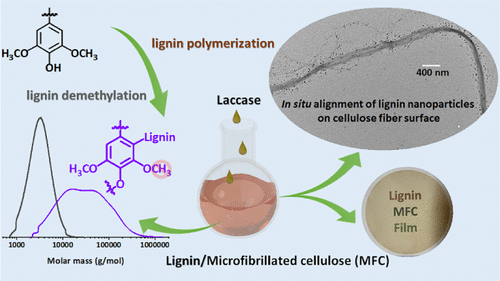当前位置:
X-MOL 学术
›
ACS Sustain. Chem. Eng.
›
论文详情
Our official English website, www.x-mol.net, welcomes your
feedback! (Note: you will need to create a separate account there.)
On Laccase-Catalyzed Polymerization of Biorefinery Lignin Fractions and Alignment of Lignin Nanoparticles on the Nanocellulose Surface via One-Pot Water-Phase Synthesis
ACS Sustainable Chemistry & Engineering ( IF 7.1 ) Pub Date : 2021-06-21 , DOI: 10.1021/acssuschemeng.1c01576 Luyao Wang 1 , Liping Tan 1, 2 , Liqiu Hu 1 , Xiaoju Wang 1 , Rajesh Koppolu 1 , Teija Tirri 3 , Bas van Bochove 4 , Petri Ihalainen 5 , Liji Sobhana Seleenmary Sobhanadhas 5 , Jukka V. Seppälä 4 , Stefan Willför 1 , Martti Toivakka 1 , Chunlin Xu 1
ACS Sustainable Chemistry & Engineering ( IF 7.1 ) Pub Date : 2021-06-21 , DOI: 10.1021/acssuschemeng.1c01576 Luyao Wang 1 , Liping Tan 1, 2 , Liqiu Hu 1 , Xiaoju Wang 1 , Rajesh Koppolu 1 , Teija Tirri 3 , Bas van Bochove 4 , Petri Ihalainen 5 , Liji Sobhana Seleenmary Sobhanadhas 5 , Jukka V. Seppälä 4 , Stefan Willför 1 , Martti Toivakka 1 , Chunlin Xu 1
Affiliation

|
Two series of well-defined lignin fractions derived from birch and spruce alkaline lignin (AL) by sequential solvent fractionation (i-PrOH-EtOH-MeOH) were engaged in a structure–property-application relationship study. The bacterial-derived alkaliphilic laccase (MetZyme) extensively catalyzed the oxidation and polymerization of AL fractions in an aqueous alkaline solution (pH 10). Lignin fractions with low molar mass reached a higher polymerization degree due to more phenolic-OH groups serving as reactive sites of oxidation and better lignin-laccase accessibility arose from a lower lignin condensation degree than the high molar mass ones. In comparison, AL fractions from spruce were found to be less reactive toward the laccase-catalyzed polymerization than those from birch, which was attributed to the much pronounced aryl-vinyl moieties’ oxidation. Furthermore, in situ polymerization of birch AL fractions using microfibrillated cellulose as a structural template was conducted in an aqueous medium and a dispersion of nanocellulose with its fiber network evenly coated by aligned lignin nanoparticles was obtained. The present study not only provides fundamental insights on the laccase-assisted oxidation and polymerization of lignin but also presents a new perspective for valorizing lignin in biobased fiber products through green processing of solvent fractionation and enzymatic treatment.
中文翻译:

通过一锅水相合成法在漆酶催化下聚合生物精炼木质素馏分和木质素纳米颗粒在纳米纤维素表面的排列
通过顺序溶剂分馏从桦木和云杉碱性木质素 (AL) 中提取的两个系列明确的木质素馏分 ( i-PrOH-EtOH-MeOH) 进行了结构-性能-应用关系研究。细菌衍生的嗜碱漆酶 (MetZyme) 在碱性水溶液 (pH 10) 中广泛催化 AL 级分的氧化和聚合。具有低摩尔质量的木质素馏分达到更高的聚合度,因为更多的酚-OH 基团作为氧化的反应位点,并且比高摩尔质量的木质素缩合度低,木质素-漆酶的可及性更好。相比之下,发现来自云杉的 AL 部分对漆酶催化聚合的反应性低于来自桦木的 AL 部分,这归因于非常明显的芳基乙烯基部分的氧化。此外,就地使用微纤化纤维素作为结构模板的桦木 AL 级分在水性介质中进行聚合,获得了纳米纤维素的分散体,其纤维网络均匀地被排列的木质素纳米粒子包覆。本研究不仅为漆酶辅助木质素的氧化和聚合提供了基本见解,而且为通过溶剂分馏和酶处理的绿色加工使生物基纤维产品中的木质素增值提供了新的视角。
更新日期:2021-07-05
中文翻译:

通过一锅水相合成法在漆酶催化下聚合生物精炼木质素馏分和木质素纳米颗粒在纳米纤维素表面的排列
通过顺序溶剂分馏从桦木和云杉碱性木质素 (AL) 中提取的两个系列明确的木质素馏分 ( i-PrOH-EtOH-MeOH) 进行了结构-性能-应用关系研究。细菌衍生的嗜碱漆酶 (MetZyme) 在碱性水溶液 (pH 10) 中广泛催化 AL 级分的氧化和聚合。具有低摩尔质量的木质素馏分达到更高的聚合度,因为更多的酚-OH 基团作为氧化的反应位点,并且比高摩尔质量的木质素缩合度低,木质素-漆酶的可及性更好。相比之下,发现来自云杉的 AL 部分对漆酶催化聚合的反应性低于来自桦木的 AL 部分,这归因于非常明显的芳基乙烯基部分的氧化。此外,就地使用微纤化纤维素作为结构模板的桦木 AL 级分在水性介质中进行聚合,获得了纳米纤维素的分散体,其纤维网络均匀地被排列的木质素纳米粒子包覆。本研究不仅为漆酶辅助木质素的氧化和聚合提供了基本见解,而且为通过溶剂分馏和酶处理的绿色加工使生物基纤维产品中的木质素增值提供了新的视角。











































 京公网安备 11010802027423号
京公网安备 11010802027423号